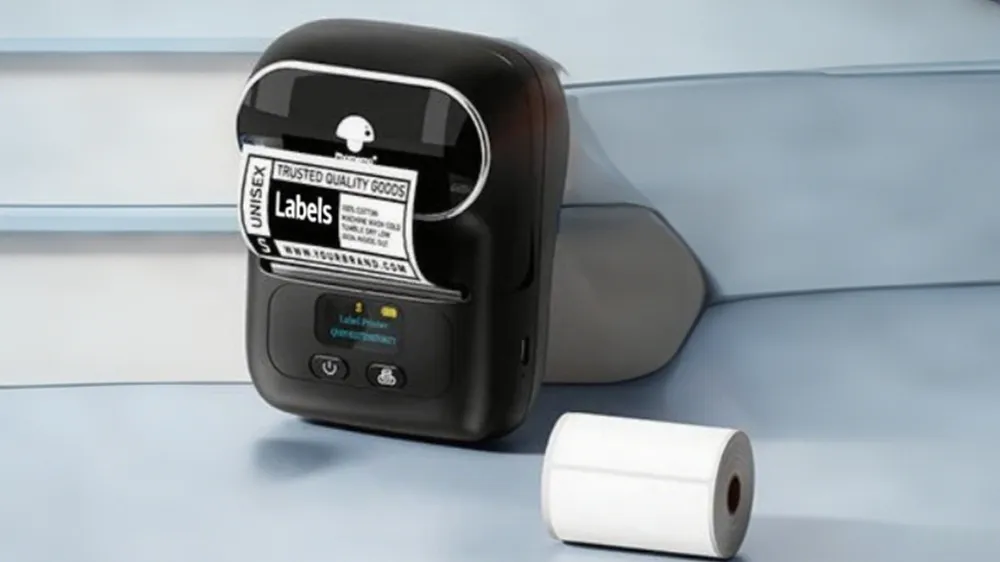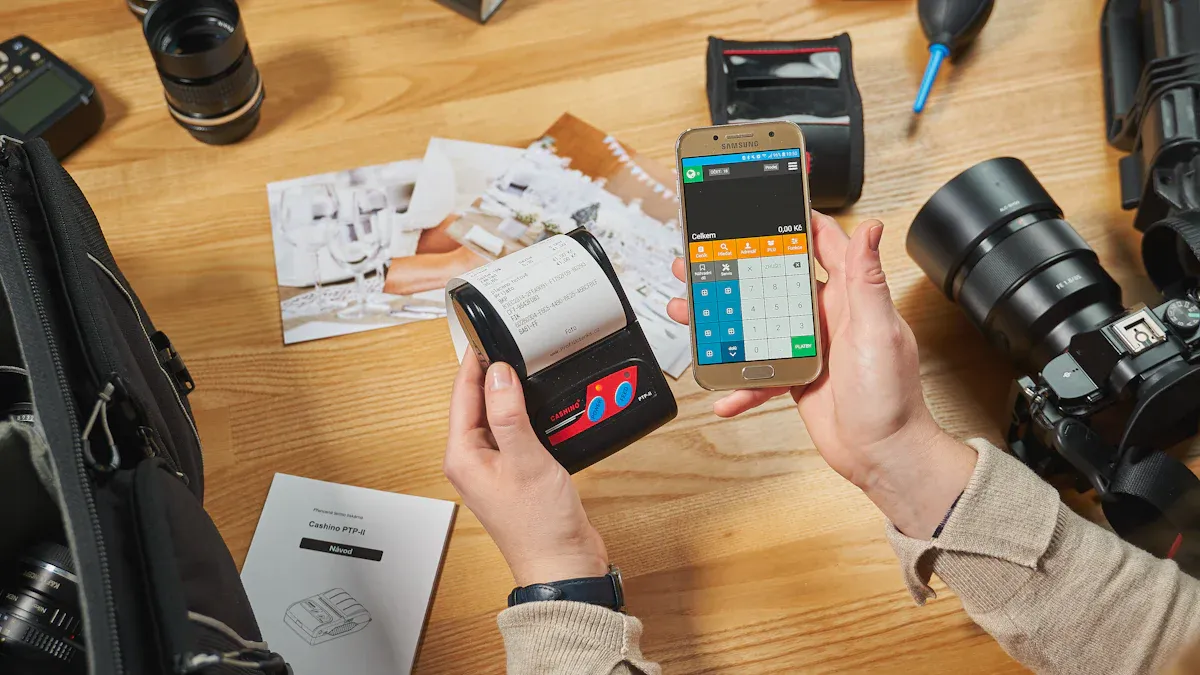
Mobile Printer Labels are sticky labels made by small printers you can carry. Workers can use these printers anywhere they need. These devices let businesses print labels right away where they are needed. This saves time and helps stop mistakes. Mobile printers are not like old label printers. They work without wires, use batteries, and can be used in hard places.
The worldwide market for these printers was worth $1.19 billion in 2023. It is growing by 7.78% each year. North America uses these printers the most.
Portable printers help people make labels exactly where they need them.
They print fast, sometimes up to 4 inches each second.
Wireless and battery power help workers during long shifts and cut down on waiting.
How do these features help businesses do their jobs better and faster?
Key Takeaways
Mobile printer labels help workers print labels anywhere. This saves time and lowers mistakes. Wireless printers use batteries and make work faster. You can print easily from phones or tablets. These labels stick well even in hard places. They come in many sizes and materials for different jobs. Using mobile printers helps businesses work faster and spend less money. They also help follow safety and compliance rules. Mobile printer labels are used in many industries. They make jobs easier in warehouses, healthcare, retail, and field services.
Mobile Printer Labels Overview

What Are Mobile Printer Labels
Mobile Printer Labels are made for portable printers. Workers use them to print information where they need it. This could be in a warehouse, hospital, or delivery truck. Most labels use direct thermal technology. The printer uses heat to make the image. There is no need for ink or toner. Labels come in many sizes and materials. This makes them good for many jobs.
Mobile Printer Labels often use direct thermal linerless labels. These labels have sticky backs and a silicone top layer. This helps them stick in cold, hot, or rough places. Clean cut technology keeps the printer clean and working longer.
Here is a table that shows the most common types and features of Mobile Printer Labels:
Attribute | Details |
|---|---|
Label Type | Mostly Direct Thermal labels |
Popular Sizes | 4 x 6, 2 x 1.25, 4 x 2, 2 x 1, 3 x 2 inches |
Materials | Paper and Synthetic |
Adhesive Types | Permanent, Ultra Aggressive, Freezer |
Format | Roll format |
Perforation Options | Perforated and Non-Perforated |
Special Features | Black mark sensing, works with Zebra, Honeywell, Citizen mobile printers |
Core Sizes | 0.5 inch, 0.75 inch, 1.00 inch |
Outer Diameter | From 1.2 inch to 5 inch |
Print Technology | Mostly Direct Thermal, some Thermal Transfer |
Color Options | Mostly White, some Yellow |
Key Features
Mobile Printer Labels have many features that help businesses. Most labels use strong glue, so they stay on many surfaces. Some labels work in very cold or hot places. Others use special glue for reusable containers or rough spots. Labels come in paper and synthetic materials like BOPP film. This makes them weatherproof.
Many mobile printers use wireless connections like Bluetooth and Wi-Fi. This lets workers print from phones or tablets anywhere. New printers are tough. They can survive drops and keep out dust and water. They work in hard places. Some printers connect to cloud systems. This makes it easy to print from online platforms and track label use.
Tip: Mobile Printer Labels can work with ERP and inventory systems. This helps companies track products and shipments in real time.
How Mobile Printer Labels Work
Technology Basics
Mobile printer labels use new technology to make labeling simple. These printers connect without wires using Bluetooth or Wi-Fi. Workers can print from phones, tablets, or computers. They do not need any cables. A smart Li-ion battery gives power, so the printer can go anywhere.
Inside, a mainboard with a CPU and memory runs each print job. The thermal print head uses heat to make the label image. This means there is no ink or toner needed. Sensors inside check the label type and help line it up right. Control panels and easy screens help users set up and use the printer.
Note: Software apps like Pro Label Tool and iPrint&Label let workers make and print labels from their mobile devices.
These features let workers print labels when they need them. They can do this even in hard places like warehouses or delivery trucks.
Typical Use Cases
Many industries use mobile printer labels to help with daily jobs. In warehouses, workers print labels for new goods, inventory, and picking orders. Forklift drivers use mobile printers to label pallets and track items. Shipping teams print packing slips and shipping labels at the dock.
Manufacturing teams use mobile printers to label parts and products.
E-commerce businesses print order labels for fast packing and shipping.
Store workers use mobile printers for shelf labels and price tags.
Healthcare workers print patient wristbands and specimen labels at the bedside.
Mobile printer labels help teams work faster and make fewer mistakes. Real-time labeling helps with tracking and better choices. Wireless printing also helps companies follow safety and compliance rules by making sure every item has the right label.
Tip: Cloud-based tools let companies track printer use and change settings from anywhere. This makes work even easier.
Business Benefits

Efficiency and Productivity
Mobile Printer Labels help businesses get work done faster. Workers can print labels right where they need them. This saves time because they do not walk back and forth. In a busy warehouse, a worker can label boxes as soon as they pack them. Nurses in hospitals print patient wristbands right at the bedside. Printing labels when needed keeps work moving and cuts down on waiting.
In shipping, teams use mobile printers to label packages at the loading dock. This makes the process faster and helps meet tight deadlines.
Mobile printers connect to phones or tablets without wires. Employees can send print jobs from anywhere. This means fewer steps and a smoother workflow. Companies save time and finish more tasks each day. This helps them get their money back quickly.
Accuracy and Error Reduction
Mobile Printer Labels help workers make fewer mistakes in many ways:
Printing labels when needed stops the use of wrong pre-printed labels.
Barcode scanners and RFID readers help print labels automatically, so people do not type in wrong data.
Because printers are portable, workers print labels right where they stick them, so there are fewer mix-ups.
Wireless connections let data move easily, so there are no mistakes from typing by hand.
Smart printers can be set up the same way and used in factories, so there is less downtime and fewer setup errors.
Not needing a PC for printing means fewer problems from computer mistakes.
Tough mobile printers work in hard places and close to where labels are needed, so there are fewer labeling errors.
In hospitals, printing specimen labels at the patient’s side lowers the chance of mix-ups. In warehouses, workers scan items and print labels right away, so every item gets the right tag.
Cost Savings
Mobile Printer Labels help companies save money in different ways:
Old labeling systems cost a lot at first and need things like pre-printed labels and ribbons, which cost more over time.
Old ways also take more time and work because people have to put labels on by hand.
Handheld printers cost less at first and do not need pre-printed labels, so companies spend less on supplies.
Handheld printers are easy to set up and move, so workers save time and do not need to walk as much.
These printers are good for small and medium labeling jobs and save money.
Stores use mobile printers to change price tags fast. This means they do not waste unused labels and pay less for work. Companies print only what they need, so they spend less on supplies and storage.
Security and Compliance
Mobile Printer Labels help keep things safe and follow rules in many jobs. Portable thermal printers make clear, easy-to-read labels. This helps companies meet rules and keep good records.
Serialization gives each item a special number, so it is easy to track and recall if needed.
Label rules include how the label looks, what it says, barcodes, and other needed parts for things like chemicals, healthcare, food, and more.
New printer solutions can handle many label sizes and types, so companies can meet special rules for their industry.
VOID Labels show a “VOID” sign if someone tries to remove them.
Destructible Security Labels break if someone tries to take them off, so they cannot be used again.
Holographic Labels help stop fake copies.
Barcode Labels help keep track of items and manage inventory.
Tamper-Seal Labels protect boxes or equipment from being opened without permission.
In medicine, mobile printers help make sure every bottle has the right label. In shipping, barcode and RFID labels help track items and stop theft.
Durability and Flexibility
Mobile Printer Labels last a long time, even in tough places. Strong labels do not fade or rub off, so information stays clear in warehouses or outside. Companies pick label materials based on heat, cold, chemicals, or water. Polyamide labels work in very hot or cold places. High-tack glue keeps labels stuck on dirty or oily things.
Strong label materials like vinyl, polyester, polyamide, and aluminum do not get ruined by sun, water, chemicals, rubbing, or heat.
Thermal transfer printing makes sharp, clear labels that do not smudge and stick well to strong materials.
Special covers and UV inks help labels last longer by stopping fading and damage.
Strong and chemical-proof glue keeps labels on dirty, oily, or rough things.
Mobile printers are also flexible. In stores, workers print new price tags or shelf labels as soon as prices change. In restaurants, staff print food labels or receipts right away. Wireless printing and printing on demand help businesses react fast to changes, sales, or seasons. This means less waste and labels are always up to date.
Tip: Printing only what is needed helps companies avoid extra supplies and supports green goals.
Industry Applications
Inventory and Shipping
Mobile printer labels are very important for inventory and shipping. Workers use portable printers to put labels on packages and products right where they are. This makes the job faster and helps stop mistakes. Many companies use printers that work with many label types, like matte, gloss, synthetic, waterproof, RFID tags, linerless, and die-cut labels. These printers can connect to inventory and shipping systems like ShipStation, Shopify, and WooCommerce. This lets labels print by themselves and keeps work moving smoothly.
A third-party logistics company used portable printers with smartphones. They made label printing 30% faster and had fewer shipping mistakes.
An online store made shipping more accurate by linking label changes to their inventory system.
Workers use smartphone apps to make and print labels in the warehouse. This helps them make fewer mistakes and work faster.
Using the same printer model helps companies save money. It also makes training and fixing printers easier.
Field Services
Field service teams need mobile printers to do their jobs well. Technicians print labels, receipts, and reports while at the job site. This helps them fix problems fast and move to the next job. Wireless printers let them print from phones or tablets. This stops mistakes from typing things by hand. Tough printers work in hard places, so technicians can label things, update inventory, and finish paperwork right there. A pest control company gave workers mobile printers and smartphones. This helped them print papers on-site, save time, and help customers better.
Mobile printer labels help field workers finish more jobs each day and give better service.
Safety and Compliance
Mobile printer labels help keep people safe and follow rules in healthcare and factories. In hospitals, staff print patient wristbands, specimen labels, and barcodes right at the bedside. This keeps patients safe and stops mistakes. Mobile printers also help companies follow rules by making clear, matching labels. They support serialization, barcodes, and QR codes, which help with tracking and following laws.
Printing medicine lists, vaccine receipts, and specimen labels when needed helps stop mistakes.
Label management software makes it easy to change labels and follow rules.
Fast, high-quality printing helps meet tough industry rules.
Versatility Across Sectors
Industry Sector | Printer Model | Key Features & Adaptability | Typical Applications |
|---|---|---|---|
Delivery & Logistics | A300 | Lightweight, supports wide labels, prints many barcode types, Bluetooth, durable, easy loading | Shipping labels, logistics labels, thermal stickers |
Retail | T260L | Compact, portable, Bluetooth, free label editing app, prints barcodes/QR codes, long battery life | Price tags, product labels, food and jewelry labels |
Warehouse & Logistics | T3 PRO | High-speed, supports large labels, Bluetooth, multiple charging options | Shipping, logistics, pallet labels, inventory tracking |
Field Service & Enforcement | E300 | Compact, robust, Bluetooth & USB, advanced paper detection, high-capacity battery, belt clip | Repair receipts, service reports, violation tickets |
Mobile printer labels work in many industries. Their wireless features, strong build, and many label choices make them a good pick for all kinds of businesses.
Mobile label printing helps businesses work better and faster. It makes jobs easier and helps save money. Companies finish tasks quicker and make fewer mistakes with labels. They also follow rules more easily.
Printing labels right away saves time and hard work.
Using digital systems makes inventory and shipping easier.
Strong, portable printers let people work in many places.
Many companies see that mobile printing helps them do better and give good service. Looking at how labels are made now can show ways to get even better.
FAQ
What types of labels work with mobile printers?
Most mobile printers use direct thermal labels. These labels can be made from paper or synthetic stuff. Some labels do not get ruined by water, heat, or cold. Many companies make different sizes for shipping, inventory, and healthcare jobs.
How long does a mobile printer battery last?
A mobile printer battery often lasts for a whole work shift. Some printers can print up to 1,000 labels before charging again. How long the battery lasts depends on label size, print speed, and printer type.
Can mobile printers connect to smartphones?
Yes, most mobile printers can connect to smartphones with Bluetooth or Wi-Fi. Workers can print labels from apps on their phones. This helps teams finish jobs faster and make fewer mistakes.
Are mobile printer labels safe for food or medicine?
Many mobile printer labels are safe for food and medicine use. Companies should look for FDA or other safety approvals. Special glue and materials help keep labels safe for touching food or medicine.
What maintenance do mobile printers need?
Mobile printers need to have the print head and sensors cleaned often. Users should look for dust or sticky stuff from labels. Changing batteries and using the right labels helps the printer work longer.
